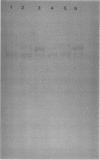Abstract
Eight mutants of barley (Hordeum vulgare cv Maris Mink) lacking the chloroplast isozyme of glutamine synthetase (EC 6.3.1.2.) were isolated by their inability to grow under photorespiratory conditions. The cytoplasmic isozyme of glutamine synthetase was present in the leaves of all the mutants, with activities comparable to the wild-type (10-12 nanokatals per gram fresh weight). The mutant plants developed normally and were fully fertile under conditions that minimize photorespiration. In 1% O2 the rate of CO2 fixation in leaves of one of the mutants, RPr 83/32, was the same as the wild-type, but in air this rate declined to 60% of the wild-type after 30 minutes. During this time the ammonia concentration in leaves of the mutant rose from 1 to 50 micromoles per gram fresh weight. Such ammonia accumulation in air was found in all the mutant lines. In back-crosses with the parent line, F1 plants were viable in air. In the F2 generation, nonviability in air and the lack of chloroplast glutamine synthetase co-segregated, in both the lines tested. These two lines and four others proved to be allelic; we designate them gln 2a-f. The characteristics of these mutants conclusively demonstrate the major role of chloroplast glutamine synthetase in photorespiration and its associated nitrogen recycling.
Full text
PDF



Images in this article
Selected References
These references are in PubMed. This may not be the complete list of references from this article.
- Krogmann D. W., Jagendorf A. T., Avron M. Uncouplers of Spinach Chloroplast Photosynthetic Phosphorylation. Plant Physiol. 1959 May;34(3):272–277. doi: 10.1104/pp.34.3.272. [DOI] [PMC free article] [PubMed] [Google Scholar]
- Lara M., Porta H., Padilla J., Folch J., Sánchez F. Heterogeneity of Glutamine Synthetase Polypeptides in Phaseolus vulgaris L. Plant Physiol. 1984 Dec;76(4):1019–1023. doi: 10.1104/pp.76.4.1019. [DOI] [PMC free article] [PubMed] [Google Scholar]
- McNally S. F., Hirel B., Gadal P., Mann A. F., Stewart G. R. Glutamine Synthetases of Higher Plants : Evidence for a Specific Isoform Content Related to Their Possible Physiological Role and Their Compartmentation within the Leaf. Plant Physiol. 1983 May;72(1):22–25. doi: 10.1104/pp.72.1.22. [DOI] [PMC free article] [PubMed] [Google Scholar]
- Walker K. A., Givan C. V., Keys A. J. Glutamic Acid metabolism and the photorespiratory nitrogen cycle in wheat leaves: metabolic consequences of elevated ammonia concentrations and of blocking ammonia assimilation. Plant Physiol. 1984 May;75(1):60–66. doi: 10.1104/pp.75.1.60. [DOI] [PMC free article] [PubMed] [Google Scholar]
- Wallsgrove R. M., Lea P. J., Miflin B. J. Distribution of the Enzymes of Nitrogen Assimilation within the Pea Leaf Cell. Plant Physiol. 1979 Feb;63(2):232–236. doi: 10.1104/pp.63.2.232. [DOI] [PMC free article] [PubMed] [Google Scholar]
- Yamaya T., Oaks A., Matsumoto H. Characteristics of glutamate dehydrogenase in mitochondria prepared from corn shoots. Plant Physiol. 1984 Dec;76(4):1009–1013. doi: 10.1104/pp.76.4.1009. [DOI] [PMC free article] [PubMed] [Google Scholar]



